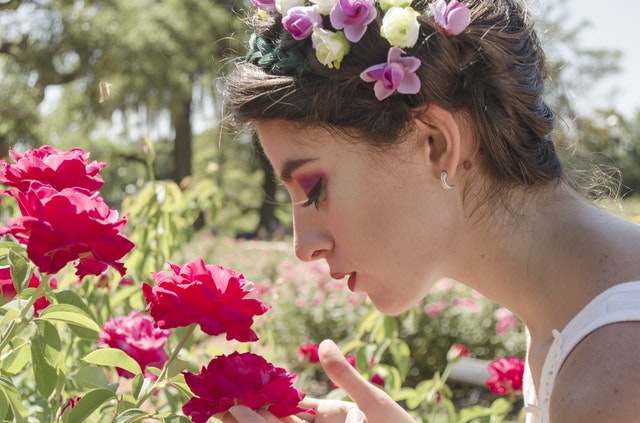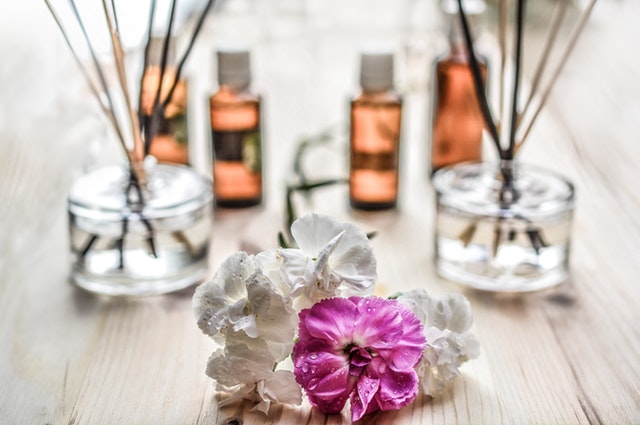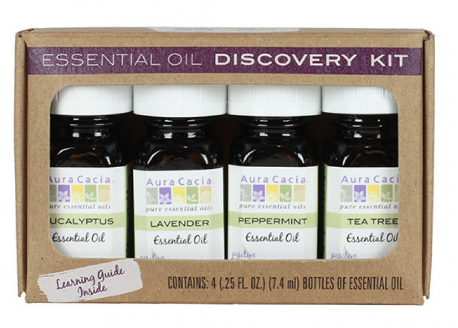
Stop and smell the roses…and more…for a boost to your mood and body!
There’s a common icebreaker game played at the start of new school years or club meetings or any potentially awkward situation, where the question “what superpower would you have?” is posed as if it were some kind of deep psychological test of one’s inner desire, potential “belonging,” or degree of psychosis. Usually, the choices are invisibility or flying, but as someone who will spend hours changing all the fonts and settings on a new computer before using it (i.e., someone who doesn’t just accept the defaults), those superpowers never quite fit my personality. I always said my desired superpower was to always smell good. If you’re laughing right now, you’re not alone, because I got a fair share of funny looks for wanting my power to be so overtly non-super, and even downright clinical-sounding.
It might actually be true that this game is indicative of some deeper part of your identity because I’m now spending a lot of time where smell can drastically affect my experience and that of others, and my attunement to it is coming in handy big time. As a yoga teacher, I rely on scent to create a certain atmosphere in my classroom; and as a student, I know how it can shift my focus away from the practice to thinking of where the closest drug store is (wink, wink). I won’t get into scent etiquette at the yoga studio here, but rather I bring it up hoping to show that smelling good is not really so easy to achieve no matter how hard you try; even “enlightened” yogis sweat. Thinking more broadly to other social situations, like job interviews or dates, achieving an optimal smell that overcomes the scent’s inherent subjectivity is, in my book, an even more important and potentially life-changing skill than flying or invisibility.
Myriad studies have explored the way that smell impacts our relationships and our tastebuds, directs advertising and marketing campaigns for food and beauty products galore, and a host of other daily decisions. Taking control of your own scent, therefore, is a surefire way to ensure that the decisions you make in every moment, no matter how big or small, are most effective and happiness-inducing.
You don’t have to spend all your money on expensive, chemical-laden perfumes or turn your home in o a candle shop or apothecary, though. Instead, simply build an at-home arsenal of these key essential oils, which can be combined in infinite ways depending on your needs at any given time. With just a few tiny vials, creativity, and your nose, you can sniff your way to calm, energy, sleep, intimacy, and digestive health and more, a few drops at a time.
The main and easiest ways to use essential oils in your life are:
- Body care: self-massage with daily abhyanga, on body and scalp
- Diffusers: allowing the scent to fill a room through a machine or wooden reeds (the more eco-conscious version), which draw the oils up and out into the air
- Inhalation: the most basic form, where you place 3 drops in your hand, rub your hands together clockwise 10-12 times, tent your hands over your nose and sniff deeply
All methods are equally effective but lend themselves to certain outcomes; i.e., if you’re stressing out at the office a sniff of lavender oil might do the trick; using a roller ball with rose-infused oil behind the ears is great for a date, or some with peppermint on the temples for a migraine; whereas setting the tone for a dinner party or home-spa day would call for a diffuser.
 As is true with food, buying high-quality, 100 percent organic oils is crucial for them to work their best. Even if you’re simply inhaling the scent in the air around you, it’s still penetrating your body; and if you’re rubbing it into your skin—your biggest organ and a permeable barrier to the rest of your insides—you don’t want anything sketchy to seep through. (Think: My body is a temple.) My go-to brands for oils made at the highest standard are Mountain Rose Herbs, Aura Cacia, and doTERRA, all of which sell single oils, pre-blended oils (usually for a specific purpose, like respiratory health or relaxation), and starter kits with the basics.
As is true with food, buying high-quality, 100 percent organic oils is crucial for them to work their best. Even if you’re simply inhaling the scent in the air around you, it’s still penetrating your body; and if you’re rubbing it into your skin—your biggest organ and a permeable barrier to the rest of your insides—you don’t want anything sketchy to seep through. (Think: My body is a temple.) My go-to brands for oils made at the highest standard are Mountain Rose Herbs, Aura Cacia, and doTERRA, all of which sell single oils, pre-blended oils (usually for a specific purpose, like respiratory health or relaxation), and starter kits with the basics.

Aura Cacia Discovery Kit, $24.99
Includes peppermint, lavender, eucalyptus, and tea tree oils
I encourage you to spend some time with pre-made blends or single oils to really get a sense of what speaks to you. It won’t take long given the powerful connection we have to smell (you can usually tell if you like something instantly), but when you’re working with more specific concerns, the combination can be hard to get right. This is the fun part of your oil journey because you get to make the rules and completely customize your oil blends! There are so many online resources for scent combinations, but I’ve had the best luck in just putting together scents I like and working out the ratios in trial-and-error. Start with a few drops of the smell you want to be strongest in your blend (around 6-8), then layer in complementary smells—usually something lighter and something heavier to balance it all out. Don’t overdo it, as a little goes a long way (plus these guys are expensive, so you’ll want to be resourceful).
You may also want to keep in mind your own Ayurvedic dosha—or constitution—and how these particular scents may align with you specifically (indicated with V/Vata, P/Pitta, K/Kapha). But again, the nose knows—so just because something or someone “says” that you should be attracted to a certain scent, you can’t force it. Follow your body’s lead and smell how you want to, and you’ll be a superwoman in no time.
Essential Oil Starter Kit
When you’re ready to stock up and get blending, I’d recommend these single oils, which veer slightly off the standard hit list but are at once universal and unique enough for a truly special scent experience:
Lavender
The holy grail of essential oils, lavender is a panacea that cures ailments of all sorts from stress and digestive concerns to bacteria and respiratory blockages. It blends seamlessly with other oils for combinations that are warm and sensuous or invigorating and uplifting. On its own, though, it is equally healing and can change your mindset in a second. It’s the base for almost all my blends, so I’d recommend a bigger bottle (2 oz.; most essential oils come in smaller vials) given its myriad uses. (V/P/K)
Rose
The heart wants what the heart wants, right? There’s a reason why this beautiful flower is associated with the heart and love—even though this scent could go terribly wrong in the musty, outdated direction, and some people will never come around to it. With its powerful cooling and calming properties, it’s especially good for heart/chest blends as it can ease strong negative emotions and elicit strong positive ones. It also has deep healing properties for emotional (depression) and physical (inflammation, viruses, bacteria) wounds and is known for toning and beautifying the skin. (V/P)
Geranium
Similar to rose scent-wise, this African flower does similar work to lavender but is slightly more energizing in my opinion. It boasts the ability to improve kidney function and reduce inflammation and pain, so there’s a powerful analgesic component when used on the body. Great in blends for migraines and sore muscles. (V/P)
Ylang-ylang
This strong and spicy scent is immediately recognizable and fairly new to the Western world. It’s especially good for targeting skin-related ailments like eczema and burns, but be careful as some experience side effects with overuse. (V/P)
Lemon
So fresh, so clean . . . lemon is a universal scent that again can take on many facets depending on how it’s mixed. The stimulating citrus can bring out a happy heart and a happy gut, as it easily clears out digestive and respiratory blocks. (V/K)
Sage
With a long medicinal history, sage is aptly associated with wisdom and clarity. The woodsy smell is deeply grounding but also deeply healing, for it strongly stimulates the body’s ability to clear out infection, bacteria, and other toxins in the blood, digestive tract, kidneys, and mind (i.e., brain fog). (V/K)
When combining oils for personal care, you’ll also want to choose a carrier oil to dilute the blend. On the skin, this allows for a more direct penetration and cooperation with the skin’s natural oils. Choose coconut for a cooler carrier (great for summertime and muscle relief especially); sesame, jojoba, and sweet almond are great for a more warming effect. Typically, you’ll only use about 8-15 drops of essential oil per 1 oz. bottle.
To learn more about the specifics of oil blending and for recipe ideas, check out these amazing sites:
Got a super-smell? Share your mix on social media #peacefuldumpling @jenniferkurdyla #superscents
Also by Jennifer: Is Your Milia A Sign Of Imbalance? How To Rid Yourself Of Those Pesky White Bumps
Related: Cleaning With Essential Oils Is Sorta Life-Changing. 4 DIY Spray Recipes For Your Home
6 Essential Oils For Anxiety To Use Whenever Life Just Becomes Too Much
Get more like this—Subscribe to our daily inspirational newsletter for exclusive content!
__
Photos: Pexels.com; AuraCacia.com




